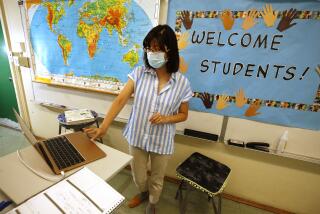PERSPECTIVE ON EDUCATION : Break the Grip of Pessimism : We need a different kind of public critique, less self-defeating, more open to the good being done in our public schools.
During a time when so many are condemning public schools and public institutions in general, I have been traveling across the country, visiting classrooms in which the promise of public education is being powerfully realized. These are classrooms judged to be good and decent places by those closest to them, places that embody the hope for a free and educated society that has, at its best, driven this extraordinary American experiment from the beginning.
We seem to be rapidly losing that hope. Our national discussion about public schools is despairing and dismissive, and it is shutting down our civic imagination. The kind of intellectual and social richness I was finding was being reflected in the public sphere.
We have instead a strange mix of apocalyptic vignettes--violent classrooms, incompetent teachers, students who think Latin is spoken in Latin America--and devastating statistics: declines in SAT scores and embarrassing cross-national comparisons. We hear--daily, it seems--that our students donât measure up, either to their predecessors here or to their peers in other countries, and that, as a result, our position in the global economy is in danger. We are told that our cultural values, indeed our very way of life is threatened. We are offered depictions of schools as mediocre places where students are vacuous and teachers are not so bright, or as violent and chaotic places where order has fled and civility has been lost. Itâs hard to imagine anything good in all this.
Though researchers have for some time challenged the simplicity of these representations--reports from the RAND Corp. and the Sandia National Laboratories, for example, dispute the alleged declines in student achievement--their challenges rarely enter our public discourse in any significant way. We seem beguiled by a rhetoric of decline, this ready store of commonplaces about how awful our schools have become.
There are many dangers in the use of such language. It blinds us to the complex lives lived out in the classroom. It preempts careful analysis of one of the nationâs most significant democratic projects. And it engenders a mood of cynicism and retrenchment, preparing the public mind for extreme responses: increased layers of testing and control, denial of new resources--even the assertion that money doesnât affect a schoolâs performance--and the curative effects of free market forces via vouchers and privatization.
What has been seen historically as a grand republican venture is beginning to be characterized as a failed social experiment, noble in intention but now moribund, perhaps headed toward extinction. So increasing numbers of people donât even consider public schools as an option for their children, and increasingly we speak, all of us, about the schools as being in decline. This is what is happening to our public discussion of education, to our collective vision of the schools.
But if you would travel with me to those classrooms in Baltimore or Kentucky or Chicago or Los Angeles, sit and watch those teachers work, listen in as students reason through a problem, walk around the neighborhoods to see what the schools provide--then the importance of public education and the limits of our portraits of it will become clear. To be sure, the visitor traveling through our nationâs schools would find burned-out teachers, lost students, boredom, violence, inertia. But if our understanding of schooling and the conception we have of whatâs possible emerge primarily from these findings, then what we can imagine for public education will be terribly narrow and impoverished.
I am not trying to ignore the obvious misery in our schools or the limitations of too many ofthose who teach in and manage them. This is not a call to abandon the critical perspective that a citizenry should have when it surveys its institutions. What I am suggesting is that we lack a public critical language adequate to the task. We need a different kind of critique, one that does not minimize the inadequacies of curriculum and instruction, the rigidity of school structure or the âsavage inequalitiesâ of funding but simultaneously opens discursive space for inspired teaching, for courage, for achievement against odds, for successful struggle, for the insight and connection that occur continuously in public school classrooms around the country. Without a multiplicity of such moments, criticism becomes one-dimensional, misses too much, is harsh, brittle, the humanity drained from it.
Public education demands a capacious critique, one that encourages both dissent and invention, fury and hope. Public education is bountiful, crowded, messy, contradictory, exuberant, tragic, frustrating and remarkable. We need an expanded vocabulary, adequate to both the daily joy and daily sorrow of our public schools. And we are in desperate need of rich, detailed images of possibility.






